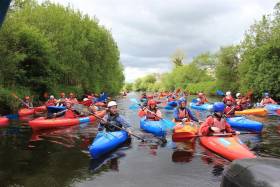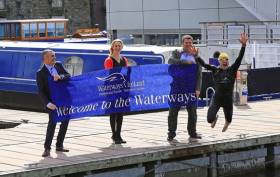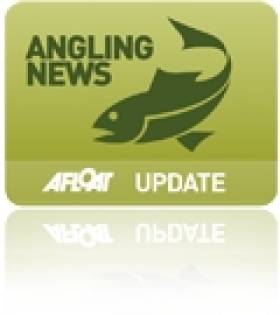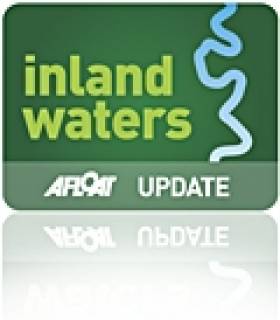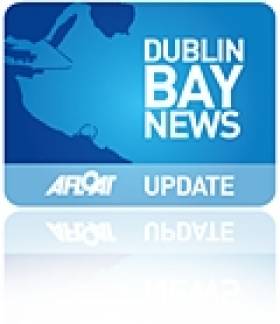Displaying items by tag: Events
Applications Now Open For Waterways Ireland’s 2019 Events Programme
#InlandWaters - The Waterways Ireland Events Programme is now open for 2019 and welcomes applications from inland waterways and waterside communities seeking support to start and grow sustainable events.
Taking place annually for the past 13 years, the programme has supported competitions, learning experiences, community, historical and educational events for people with and without disabilities across thousands of communities nationwide.
Involving angling, canoeing, rowing, sailing and power sports, arts, history, drama and learning new skills, these events have most importantly been about having fun on the waterways under the auspices of Waterways Ireland, the recreation and navigation authority for the Barrow Navigation, Erne System, Grand Canal, Lower Bann Navigation, Royal Canal, Shannon-Erne Waterway and the Shannon Navigation.
“The new vision for the event programme will activate event organisers to consider how they can build in ongoing activity and sustained use of the waterways corridors into their event,” says Sharon Lavin, head of marketing and communications with Waterways Ireland.
“Tourism and participation in recreation has a social and economic impact in waterfront communities, and events are a great way to engage communities with previously under-utilised waterways.”
The application form and guidance notes can be viewed and completed online. Terms and conditions apply. The closing date the receipt of completed applications is Wednesday 16 January.
Dun Laoghaire Harbour Company Partners With Online Platform For Leasing Event Space
#DLHarbour - Dun Laoghaire Harbour Company has announced a new event space partnership with online platform Fillit.
Four locations in the harbour will be available for rent on short-term lease for various events, pop-ups and other promotions via the new web startup “that connects people and spaces”.
The Dun Laoghaire-based company aims to provide a one-stop shop for event planners of all scales to connect with ‘landlords’ who have available space on a temporary.
The harbour plaza, the East Pier bandstand and sun shelter, Carlisle Pier and St Michael’s Pier will all be made available through Fillit for hosting events similar to those held in the harbour in the past, such as the Red Bull Flugtag and the Beatyard festival.
The news comes just weeks after the harbour company announced its plans for an urban beach are ‘on hold’ pending ‘organisational restructure’, as previously reported on Afloat.ie.
Waterways Ireland Launches 2016 Events Programme
#InlandWaters - Waterways Ireland's 2016 event programme launches 120 events celebrating the arts, heritage, adventure, and sporting communities along Ireland's inland waterways.
Now in its tenth year, the programme has sponsored over 700 events with a knock-on effect of €80m in benefits to the local waterway communities. Information on all fun activities and events can be found on the Waterways Ireland website.
Events in the programme this year include TriAthlone on Lough Ree, TriAthy X in Athy on the Barrow, the Killaloe Water Festival on Lough Derg, the Erne Classic Fishing Festival, the Shannon Blueway Adventure Festival, the Docklands Summer Festival and Phizzfest in Dublin, and the Waterways Ireland Riverfest on the Lower Bann, which this year hosts the European Boat Wakeboard Championships.
"These events supported by Waterways Ireland have revitalised rural and small urban communities, and have facilitated the development of local community associations, leading to real economic and social impacts," says Sharon Lavin, head of marketing and communications at Waterways Ireland.
"The Waterways Ireland Sponsorship Programme in 2015 supported the participation of almost 38,000 people directly in waterway activity and welcomed over 160,000 spectators to waterway events along the navigations. The economic impact of the 2015 programme along is estimated at €7.8m."
The programme announcement comes after Waterways Ireland announced its 2016 boating season, which kicked off earlier this month.
In other news, over 90 local businesses attended the 'Build Your Blueway' Networking Expo recently at The Bush Hotel in Carrick-on-Shannon, creating and developing new business opportunities across Cavan, Roscommon, Longford and Leitrim.
Organised by the Upper Shannon Erne Future Economy Project in conjunction with Waterways Ireland, the event offered activity, arts, heritage and cultural businesses the opportunity to present their business, network and develop cross-selling options with accommodation providers and others in a series of sessions.
IFI Launches 2012 Sponsorship Programme
#ANGLING - Inland Fisheries Ireland (IFI) has announced the launch of its 2012 Sponsorship Programme.
The IFI Sponsorship Programme aims to increase awareness of IFI and its work, recreational angling, the sustainable commercial use of the inland fisheries resource and habitat issues.
Applications are invited from organisers and event promoters that will support the aims of the IFI sponsorship programme.
Events would be supported on the basis of: the location and nature of the event; the potential of the event to introduce new users to angling in an active capacity (ie not just as spectators); and to educate and inform stakeholders of angling, environmental, commercial salmon fisheries and habitat issues.
"The sustainable use of our wonderful inland fisheries and sea angling resources must be promoted," said Minister for Communications, Energy and Natural Resources, Pat Rabbitte, who launched the programme.
"People of all ages can enjoy angling in urban and rural settings, off charter boats and beaches and on quiet riversides.
"In addition, traditional commercial fisheries add value to small local communities, while biodiversity awareness ensures a sustainable resource for all."
Applications and details of the sponsorship programme are available online or from your local IFI office. The closing date for submissions is 27 January 2012.
Belfast Lough Regatta Dates for 2012
#BELFAST LOUGH - Provisional dates for the 2012 Belast Lough Yachting Conference (BLYC) Regattas have been announced.
The BLYC encompasses all yacht clubs on Belfast Lough and Larne Lough and co-ordinates their individual events.
The interim schedule for 2012 runs to nine events from Saturday 9 June to Saturday 25 August:
- Sat 9 June - Royal Ulster Yacht Club
- Sat 23 June - Ballyholme Yacht Club
- Sat 7 July - Holywood Yacht Club
- Sat 21 July - East Antrim Boat Club
- Sat 28 July - County Antrim Yacht Club
- Sat 4 August - Cockle Island Boat Club
- Sat 11 August - North of Ireland Yacht Club
- Sat 18 August - Donaghadee Sailing Club
- Sat 25 August - Carrickfergus Sailing Club
Waterways Ireland 2012 Sponsorship Programme Now Open
#INLAND WATERWAYS - Waterways Ireland has announced details of its sponsorship programme for 2012.
Under the scheme, the authority for Ireland's inland waterways provides funding and support to groups, associations, clubs or other appropriate bodies to assist with events that enhance the use of the waterways for recreational purposes.
The sponsorship programme cannot be used to fund or contribute towards capital projects such as acquiring or developing new or existing buildings or infrastructure, nor acquiring or maintaining equipment.
Applications are now being accepted for the 2012 programme, and any interested parties can apply by reviewing the guidelines for eligibility and downloading the application form from the Waterways Ireland website.
The closing date for receipt of completed applications is 13 December 2011 at 3pm. Incomplete or late applications will not be assessed.
For further details contact Damien McWeeney at 071 96 50622 or [email protected].
Heritage Week: Maritime Lectures In Dun Laoghaire
12.30 – 1.30 pm. Neutral Ireland's Role in the Sinking of the Bismarck, May, 1941 By Dr. Michael Kennedy, Executive Editor, Documents on Irish Foreign Policy, Royal Irish Academy.
1.30 – 2.30 pm. Traditional Boats of Ireland. - Wooden workboats from all the Maritime Counties of Ireland. By Darina Tully, Lecturer and Maritime Archaeologist.
2.30 – 3.30 pm. Too Many Bags in the Lifeboat. A Lifeboat Tragedy at Bray 1876 By James Scannell, Lecturer and P.R.O of the Old Dublin Society.
4.00 – 5.00 pm. Maritime Guinness, The Ships, Yachts and Barges of the Guinness Dynasty. By Dr. Edward Bourke, Diver, Maritime Historian and Author of "Guinness, the Family, the Business and the Black Stuff"
5.00 – 6.00 pm. Ireland's Armada Heritage. The Story of the Spanish Armada of 1588. The discoveries of the wrecks on the Irish Coast and the recovery of artifacts. By Cormac Lowth, Lecturer, Author and Diver.
Further information Barney Yourell 087 900 7466 No seminar charge – donations accepted. Information in general on the Maritime Institute of Ireland can be found on http://www.mariner.ieand for other nationwide events of the Heritage Week visit www.heritageweek.ie
- Events
- Dun Laoghaire Harbour
- M.I.I.
- Dun Laoghaire Harbour News
- Event news
- National Heritage Week
- Heritage Week
- Maritime Lecture Seminar
- Spanish Armada
- Eblana Centre Dun Laoghaire
- Maritime Insitute of Ireland
- Bismarck
- Traditional Irish wooden boats
- Guiness ships
- Guinness barges
- Darina Tully
- Irish heritage boats
'Seafront Memorials' Tours of Dun Laoghaire Harbour
The tour which is free starts at the meeting point of the Queen Victoria Fountain which too forms part of the tour alongside the George VI memorial
and the Christ the King monument.
The outdoor event is part of the 'Summer of Heritage' which is organised by Dun Laoghaire-Rathdown County Council. The initiative is now in its fourth year and this year's highlight of the programme are tours of the newly renovated Seapoint Martello tower.
The coastal structure has been restored and is a fine example of these 19th century defensive forts, built along the coast to defend during the Napoleonic wars.
This summer also sees Carrickbrennan graveyard feature for the first time, the resting place of many sailors lost in maritime disasters since the 17th century.
Sightseeing along 'The Metals', a historic pathway that linked the quarry in Dalkey to the harbour in Dún Laoghaire also returns in the programme due to its popularity last year.
To read more about the the Summer of Heritage other free events in the arts, literature, sports, music and for the family, go to www.dunlaoghaire.ie/summer-of-heritage/ and www.dlrevents.ie/heritage11.html
- Events
- RNLI
- dlrcoco
- Dublin Bay News
- Dun Laoghaire Harbour
- Coastal Notes
- Dun Laoghaire News
- Seafront Memorials
- Guided Tours
- DunLaoghaireRathdown County Council
- DLR
- DLR events
- Martello Towers
- Seapoint Martello Tower
- The 'Metals'
- Queen Victoria Fountain
- King George VI monument
- Crimean War cannon
- Event news
- Napoleon
- Napoleonic Wars
- 1895 Dun Laoghaire Lifeboat Disaster
- RNLI Dun Laoghaire
- Christ the King monument
- Summer of Heritage
Dublin Bay it set to burst alive with 'joie de vivre' during the only foreign stopover in the world-famous Solitaire du Figaro yacht race.
Dun Laoghaire will be the only international stop in the race, considered the unofficial world offshore solo championship, between 11 and 14 August.
To celebrate the visit of the iconic 3,390km race, Dun Laoghaire Rathdown County Council (dlrcoco), the Dun Laoghaire Harbour Company and the National Yacht Club have joined forces to create the Festival des Bateaux.
The harbour will be a magnificent tapestry of colour as the boats arrive for this international event. Dun Laoghaire will be resplendent with fireworks, music and the sights, sounds, foods and ‘joie de vivre’ of France.
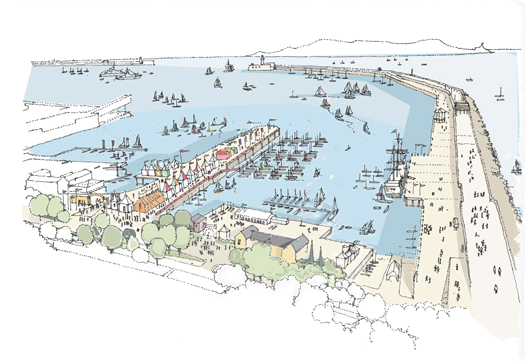
How Dun Laoghaire will look in August
Fireworks will light up the sky at 10pm on Friday 12 August. There will also be a festival village with public access to visiting boats, a colourful and authentic French market and exhibition, a festival stage at Harbour Plaza and activities throughout Dun Laoghaire, not to mention a spectacular farewell as the boats depart early on Sunday 14 August.
Meanwhile, plans to berth the 45 or so competitors expected are well underway, according to the National Yacht Club.
Funding was secured between dlrcoco and Fáilte Ireland, and the tender for the supply and delivery of 18x11.5m pontoons and associated service bollards was won by McNiven Marine, Irish agents for Ronautica Marine.
The gangway contract was secured by Tynes Gangway, and the last contract for the installation and de-commissioning of the infrastructure is currently underway.
Fishing Exhibition Show Heads for Galway
The exhibition times are Friday 4th March (10:00am - 5:30pm) and on Saturday 5th March the opening hours are repeated (10:00am - 5:30pm). For further information on the trade-only show Tel: (053) 74 954 8037 / 954 8935 or by clicking here


























